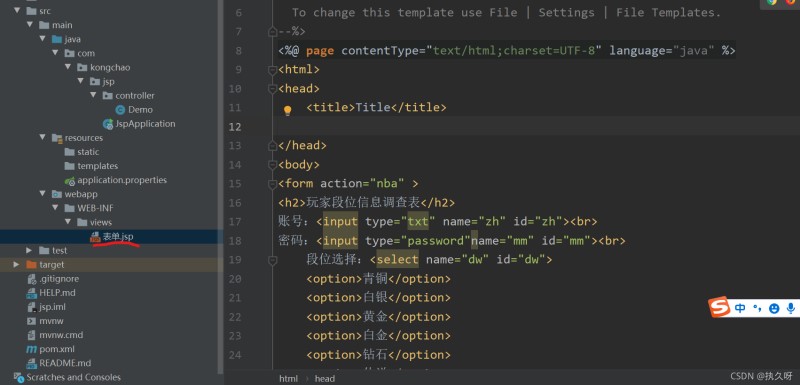目录
- 前言
- JSON.stringify六大特性
- 特性一
- 特性二
- 特性三
- 特性四
- 特性五
- 特性六
- 手动实现stringify
- 总结
前言
JSON.stringify是一个使用非常高频的API,但是其却存在一个特性,我们在使用的过程中需要留意这些特性以避免为代码程序埋雷,那么接下来便一起动手实现一个简易版本的jsonStringify函数
JSON.stringify六大特性
特性一
布尔值、数字、字符串的包装对象在序列化过程中会自动转换成对应的原始值
现在有这么一个对象:
const obj = {
bol: new Boolean(true),
num: new Number(1),
str: new String(1)
}
利用typeof检测obj各个属性的数据类型
typeof obj.bol; // object typeof obj.num; // object typeof obj.str; // object
将其序列化stringify之后
JSON.stringify(obj); // {"bol":true,"num":1,"str":"1"}
此时再将其解析parse进行各个属性的数据类型
const stringifyObj = JSON.parse(JSON.stringify(obj)); typeof stringifyObj.bol; // boolean typeof stringifyObj.num; // number typeof stringifyObj.str; // string
特性二
NaN、Infinity、-Infinity以及null在序列化stringify时都会被当作null
const obj = {
nan: NaN,
infinity: Infinity,
null: null,
};
JSON.stringify(obj); // {"nan":null,"infinity":null,"null":null}
特性三
对象在序列化的时候,若是其存在toJSON函数,这个函数返回的值就是整个对象序列化后的结果
const obj = {
nan: NaN,
infinity: Infinity,
null: null,
toJSON() {
return "拥有toJSON函数";
},
};
JSON.stringify(obj); // "拥有toJSON函数"
可以看到序列化之后的数据仅存在toJSON函数的返回值,其余数据全部忽略
️:Date数据会被正常序列化,因为Date上部署了toJSON函数,可以通过控制台打印Date.prototype.toJSON得知
const obj = {
date: new Date(),
};
JSON.stringify(obj); // {"date":"2021-10-08T11:43:31.881Z"}
特性四
表现不一的undefined、function和symbol
作为对象键值对时:
作为值:
const obj = {
undefined: undefined,
fn() {},
symbol: Symbol()
};
JSON.stringify(obj); // {}
作为键:
const fn = function () {};
const obj = {
[undefined]: undefined,
[fn]: function () {},
[Symbol()]: Symbol()
};
JSON.stringify(obj); // {}
undefined、function和symbol作为对象的key和value时,会在序列化时将其忽略
️:此时可能会改变对象原有的顺序,因为上述三种数据会在序列化时被忽略
作为数组值时:
const arr = [undefined, function fn() {}, Symbol()];
JSON.stringify(arr); // [null,null,null]
undefined、function和symbol作为数组的value时,会在序列化时将其都转换为null
单独存在时:
JSON.stringify(undefined); // undefined
JSON.stringify(function () {}); // undefined
JSON.stringify(Symbol()); // undefined
undefined、function和symbol单独存在时,会在序列化时都转换为undefined
特性五
序列化过程中,仅会序列化可枚举属性,不可枚举属性将会忽视
const obj = {
name: "nordon",
age: 18,
};
// 将age修改为不可枚举属性
Object.defineProperty(obj, "age", {
enumerable: false,
});
JSON.stringify(obj); // {"name":"nordon"}
️:此举也会改变对象的原有顺序
特性六
循环引用的对象,会在序列化时抛出异常
const obj = {
name: "nordon",
age: 18,
};
const p = {
name: 'wy',
obj
}
obj.p = p
JSON.stringify(obj);
此时会导致控制台抛出异常:
Uncaught TypeError: Converting circular structure to JSON –> starting at object with constructor ‘Object’ | property ‘p’ -> object with constructor ‘Object’ — property ‘obj’ closes the circle at JSON.stringify (<anonymous>)
手动实现stringify
明白了JSON.stringify的一些特性,接下来便可以依据这些特性动手实现一个kack版本
在动手实现之前,先利用柯里化封装一些数据类型校验的工具函数:
const currying = (fn, ...outParams) => {
// 获取 fn 函数需要的参数个数
const paramsLen = fn.length;
return (...args) => {
// 收集全部参数
let params = [...outParams, ...args];
// 若参数没有达到 fn 需要的参数,继续收集参数
if (params.length < paramsLen) {
return currying(fn, ...params);
}
return fn(...params);
};
};
/**
* type: 类型 - [object Array]、[object Number]等
* source: 数据源
*/
const judgeType = (type, source) => {
return Object.prototype.toString.call(source) === type;
};
const isUndefined = currying(judgeType, "[object Undefined]");
const isSymbol = currying(judgeType, "[object Symbol]");
const isFunction = currying(judgeType, "[object Function]");
const isObject = currying(judgeType, "[object Object]");
const isNull = currying(judgeType, "[object Null]");
下面直接上代码:
function jsonStringify(data) {
let type = typeof data;
if (isNull(data)) {
// null 直接返回 字符串'null'
return "null";
} else if (data.toJSON && typeof data.toJSON === "function") {
// 配置了 toJSON函数, 直接使用 toJSON 返回的数据且忽略其他数据
return jsonStringify(data.toJSON());
} else if (Array.isArray(data)) {
let result = [];
//如果是数组,那么数组里面的每一项类型又有可能是多样的
data.forEach((item, index) => {
if (isUndefined(item) || isSymbol(item) || isFunction(item)) {
result[index] = "null";
} else {
result[index] = jsonStringify(item);
}
});
result = "[" + result + "]";
return result.replace(/'/g, '"');
} else if (isObject(data)) {
// 处理普通对象
let result = [];
Object.keys(data).forEach((item, index) => {
if (typeof item !== "symbol") {
//key 如果是 symbol 对象,忽略
if (
data[item] !== undefined &&
typeof data[item] !== "function" &&
typeof data[item] !== "symbol"
) {
//键值如果是 undefined、function、symbol 为属性值,忽略
result.push(
'"' + item + '"' + ":" + jsonStringify(data[item])
);
}
}
});
return ("{" + result + "}").replace(/'/g, '"');
} else if (type !== "object") {
let result = data;
//data 可能是基础数据类型的情况在这里处理
if (Number.isNaN(data) || data === Infinity) {
//NaN 和 Infinity 序列化返回 "null"
result = "null";
} else if (isUndefined(data) || isSymbol(data) || isFunction(data)) {
// 由于 function 序列化返回 undefined,因此和 undefined、symbol 一起处理
return undefined;
} else if (type === "string") {
result = '"' + data + '"';
}
return String(result);
}
}
至此简易版本的JSON.stringify完成,虽然能力尚欠缺许多,主要是提供一个思路,核心注释已注释在代码中,可结合代码和上文的特性一起理解
总结
到此这篇关于JSON.stringify实现及其六大特性详解的文章就介绍到这了,更多相关简易版本JSON.stringify及特性内容请搜索NICE源码以前的文章或继续浏览下面的相关文章希望大家以后多多支持NICE源码!









